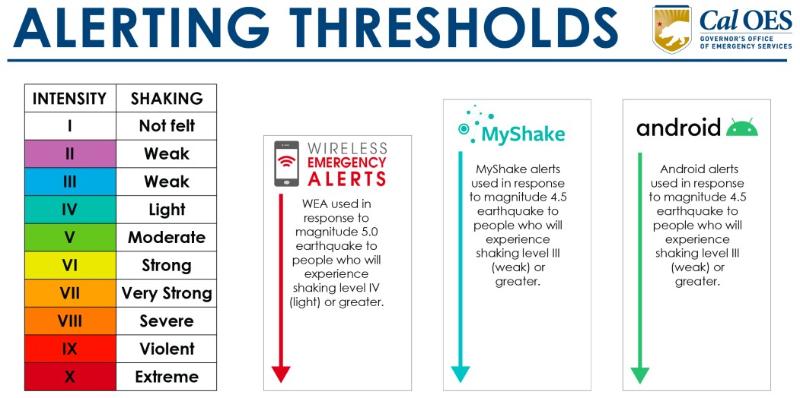
Learn more about ShakeAlert:
An Earthquake Early Warning System for the West Coast of the United States
Download the MyShake App iOS or Android to receive these early warnings on your smartphone.
An earthquake is a sudden, rapid shaking of the ground caused by the shifting of rocks deep underneath the earth’s surface. Earthquakes can cause fires, tsunamis, landslides or avalanches. While they can happen anywhere without warning, areas at higher risk for earthquakes include Alaska, Hawaii, Oregon, Puerto Rico, Washington, the entire Mississippi River Valley and right here in California.

DROP where you are onto your hands and knees.
- This position protects you from being knocked down and also allows you to stay low and crawl to shelter if nearby.
COVER your head and neck with one arm and hand
- If a sturdy table or desk is nearby, crawl underneath it for shelter.
- If no shelter is nearby, crawl next to an interior wall (away from windows).
- Stay on your knees; bend over to protect vital organs.
HOLD ON until shaking stops
- Under shelter: hold on to your shelter with one hand; be ready to move with it if it shifts.
- No shelter: hold on to your head and neck with both arms and hands.
What to do when the ground stops shaking?
The moment the ground stops shaking it is important to take action quickly and safely. Check for injuries and damages that need immediate attention. If you have training in first aid, assist those in need. Look around your environment to identify any new hazards such as leaking gas lines, damage to the building, water or electric lines, or other things that may be dangerous, especially if there are aftershocks.
Evacuate your office or residence hall only if there is damage to the building or the surrounding area is unsafe. If your building’s fire alarm is sounding, relocate to your designated Emergency Assembly Point as safely as possible.
If you are trapped by falling items or a collapse, protect your mouth, nose, and eyes from dust. If you are bleeding, put pressure on the wound and elevate the injured part. Call or text 911 for help, or knock loudly on solid pieces of the building, three times every few minutes. Rescue personnel will be listening for such sounds.
Once you are safe, help others and check for damage.
Prevent further injuries or damage. Be prepared for aftershocks and stay away from anything that looks like it may fall.
- Fire. If you are trained and have a fire extinguisher handy, put out small fires in your home or neighborhood immediately. Call for help, but don’t wait for the fire department. Large fires are a sign to evacuate.
- Gas Leaks. Shut off the main gas valve only if you suspect a leak because of broken pipes, the odor or sound of leaking natural gas, or you see the meter spinning quickly. Only the gas company can turn the gas back on after they check for leaks, so shut it off only if necessary. The phone book has detailed information on this topic. Do not use candles or matches. You could start a fire and there may also be gas leaks. Use your flashlights, battery powered lights, and light sticks.
- Damaged Electrical Wiring. Shut off power at the main breaker switch if there is any damage to your house wiring. Leave the power off until the damage is repaired.
- Broken Lights and Appliances. Unplug these as they could start fires when electricity is restored.
- Downed Power Lines. If you see downed power lines, consider them energized and stay well away from them. Keep others away from them also. Never touch downed power lines or any objects in contact with them.
- Fallen Items. Beware of items tumbling off shelves when you open the doors of closets and cupboards.
- Spills. Use extreme caution. Clean up any spilled medicines, drugs, or other non-toxic substances. Potentially harmful materials such as bleach, lye, garden chemicals, and gasoline or other petroleum products should be isolated or covered with an absorbent such as dirt or cat litter. When in doubt, leave your home.
Earthquake Warning System:
"The Earthquake Early Warning system uses science, state-of-the-art ground motion monitoring, as well as new and existing alerting methods to deliver warnings to people via cell phones before the strongest shaking arrives. Seconds to tens of seconds of alert can provide opportunity to take life-saving actions such as Drop, Cover, and Hold On and put devices into various forms of a safe mode. The speed of the alert will vary depending on one’s distance from the origin of the earthquake. The closer one is to origin, the quicker one will receive the alert. In some cases people may receive an alert once they feel shaking or after an earthquake passes.
For the first time, you can receive warning of an earthquake before you feel shaking. Earthquake Warning California can give you seconds of notice using the following tools:
- MyShake App
- Android Earthquake Alerts
- Wireless Emergency Alerts (WEAs)."
- Cal OES

Additional Resources